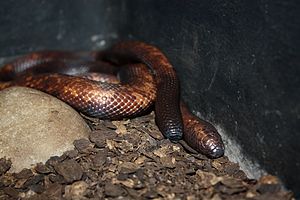Earth python
| Earth python | ||||||||||||
|---|---|---|---|---|---|---|---|---|---|---|---|---|

Earth python ( Calabaria reinhardtii ) |
||||||||||||
| Systematics | ||||||||||||
|
||||||||||||
| Scientific name of the subfamily | ||||||||||||
| Calabariinae | ||||||||||||
| JE Gray , 1858 | ||||||||||||
| Scientific name of the genus | ||||||||||||
| Calabaria | ||||||||||||
| JE Gray, 1858 | ||||||||||||
| Scientific name of the species | ||||||||||||
| Calabaria reinhardtii | ||||||||||||
| ( Schlegel , 1848) |
The earth python ( Calabaria reinhardtii ) is an African snake species from the boas (Boidae) family, which occurs in western and central African rainforest areas from Guinea to the north of the Republic of the Congo and the western Central African Republic . It is the only species of the genus Calabaria , which was named after the port city of Calabar in southeastern Nigeria; the species epithet honors the Danish zoologist Johannes Theodor Reinhardt .
features
The earth python reaches a length of 80 cm to one meter. The small head, the body and the blunt, very short tail are not separated from each other and have about the same diameter. The eyes are small and have vertical pupils. They are brown in color, as are the scales around the eyes. The mouth is small, inconspicuous and not suitable for consuming larger prey. The palate is edentulous. Sensory organs for the perception of infrared radiation are missing. The back and sides of the body are black-brown, brown or red-brown and patterned with lighter, irregular, reddish or yellowish spots. The head and tail are darker. The ventral side is brown or gray and lighter than the back and flanks. It can be spotted brown. The scales are shiny and smooth.
The earth python differs from all other boas in its oviparous (egg-laying) method of reproduction (hence the reference to the pythons in the German trivial name ), while all other boas are ovoviviparous, i.e. they give birth to living young. Other differences from other boas include the edentulous palatine bone , the toothed intermaxillary bone (premaxillary), supraorbital bones without dorsal outgrowth and enlarged scalp.
Systematics
The Calabar Python was the German herpetoculturists and Ornithologen 1848 Hermann Schlegel described and initially the sand boas ( Eryx assigned). In 1858 the British zoologist John Edward Gray established the genus Calabaria for the species that has since remained monotypical . Later the species was partially assigned to the pythons or synonymized with the genus Charina . Molecular genetic analyzes, however, show that the species can be assigned to the boa species, but differs significantly from all other boa species. The Reptile Database assigns them to the subfamily Calabariinae within the family of the Boas (Boidae). The Calabariidae family proposed by Alexander Pyron and co-workers for the earth python has so far not been able to establish itself, as it would make the boas paraphyletic.
literature
- E. Cimatti: Calabaria reinhardtii, African Burrowing Python. In: Reptilia (GB). 28, 2003, pp. 66-67.
- R. Alexander Pyron, R. Graham Reynolds, Frank T. Burbrink: A Taxonomic Revision of Boas (Serpentes: Boidae). In: Zootaxa. 3846, No. 2, 2014, pp. 249–260, doi : 10.11646 / zootaxa.3846.2.5 ( PDF ).
- Van Wallach, Kenneth L. Williams, Jeff Boundy: Snakes of the World: A Catalog of Living and Extinct Species. Productivity Pr Inc, ISBN 978-1482208474 ( limited preview in Google Book Search).